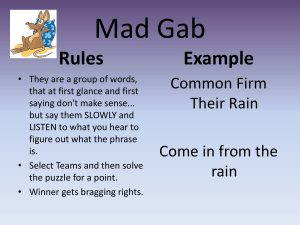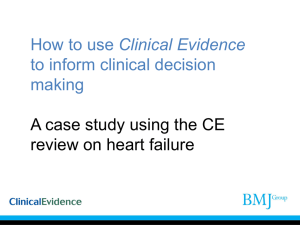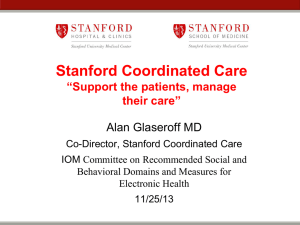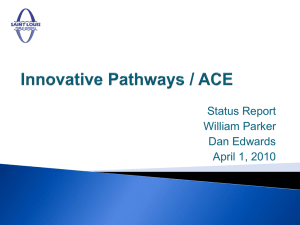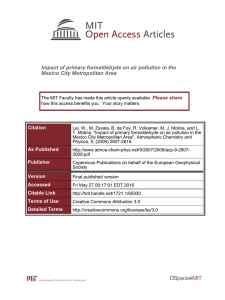T4.4-Bernath
advertisement
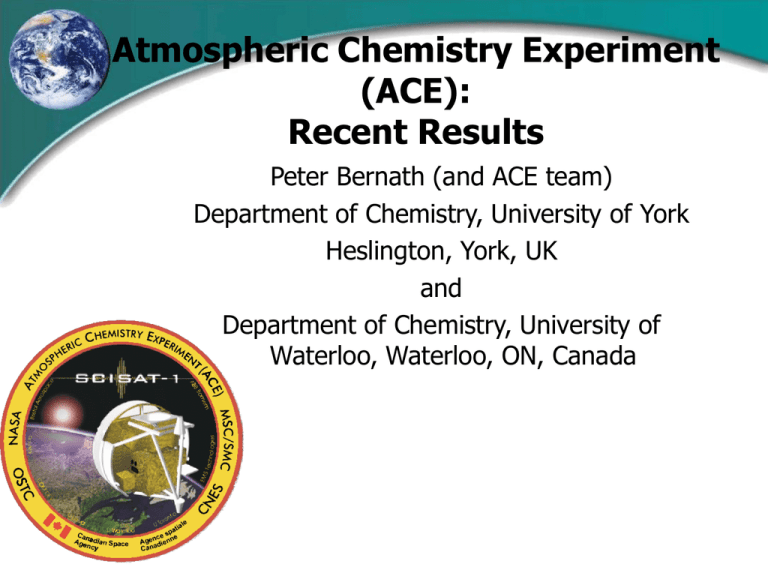
Atmospheric Chemistry Experiment (ACE): Recent Results Peter Bernath (and ACE team) Department of Chemistry, University of York Heslington, York, UK and Department of Chemistry, University of Waterloo, Waterloo, ON, Canada ACE Satellite See http://www.ace.uwaterloo.ca Solar Occultation Advantages: Radiance of sun gives higher S/N than emission Limb view gives longer path length ~500 km (lower detection limits) than nadir “Self-calibrating” so excellent long-term accuracy and precision Disadvantages: Modest global coverage Samples only free troposphere Timeline Jan. 1998 Proposal to CSA Feb. 2001 FTS and Imager CDR Mar. 2001 MAESTRO CDR Jun. 2001 Bus CDR Sept. 2002 S/C integration & test Mar. 2003 Instrument test (Toronto) May 2003 Final integration (DFL) Aug. 2003 Launch Sept. 2003 Commissioning Feb. 2004 Routine operations Mar. 2004 Arctic campaign Feb. 2005 Arctic campaign Feb. 2006 Arctic campaign Feb. 2007 Arctic campaign Feb. 2008 Arctic campaign First ACE data Feb. 2004, mission currently approved to March 2010. Mission had a 2year lifetime – fifth anniversary Aug. 2008. Instruments Infrared Fourier Transform Spectrometer operating between 2 and 13 microns with a resolution of 0.02 cm-1 2-channel visible/near infrared Imagers, operating at 0.525 and 1.02 microns (cf., SAGE II) Suntracker keeps the instruments pointed at the sun’s radiometric center. UV / Visible spectrometer (MAESTRO) 0.4 to 1.03 microns, resolution ~1-2 nm Startracker Bernath et al. GRL, 32, L15S01 (2005) SCISAT-1 Spacecraft (Bristol) Key Specifications Spacecraft diameter Spacecraft mass Pointing control: Pitch/yaw (3 ) Roll (3 ) Pointing knowledge: Pitch/yaw Roll Solar array EOL power Spacecraft OA power Bus reliability (2-yrs) Mass memory 112 cm 152 kg ± 0.2º ± 0.7º ± 0.1º ± 0.6º 175 W 75 W 80 % 1.5 Gb Optical Layout (ABB-Bomem) INT corner-cube INT corner-cube mirror (11) mirror (10) Beamsplitter/ compensator assembly (8) (12): Reflective coating (9): B/S coating (12) Laser Metrology Detection (9) End mirror (13) IR Filter (7) O utp ut c onde ns er (14) (15) C o ole r w ind ow (17) D i chroi c 1.02 m G l are s top (16) Lens (18) Laser Metrology Insertion 1.02 m Dichroic Lenses filter (25) (24) (23) Seconday Fold mirror mirror (6) (22) imager (26) G lare sto p 0.525 m Lens PV M C T D ete cto r Beam splitter Compensator Fold mirror Field stop (5) 0.525 m filter (27) Ap erture s top (4) imager (28) P V InS b Suntracker mirror (1) Lenses (20) D etec tor VIS/NIR-Quad Cell Dichroic Quad Cell (21) 1.55 m filter (19) MAESTRO Primary mirror (3) Interface (2) Solar input MAESTRO MAESTRO PI: T. McElroy, MSC Dual concave grating spectrograph, 1-2 nm resolution Global Occultation Distribution FTS – Decontamination Results After 6 months operation After decontamination Ryan Hughes Occultation sequence ACE-FTS Species Measured Baseline species (version 2.2): H2O, O3, N2O, CO, CH4, NO, NO2, HNO3, HF, HCl, N2O5, ClONO2, CCl2F2, CCl3F, as well as pressure and temperature from CO2 lines Other routine species: COF2, CHF2Cl, CF4, CH3Cl, C2H6, SF6, OCS, HCN Research species: CCl4, HOCl, H2O2, HO2NO2, CCl2FCClF2, CH3CClF2, ClO, C2H2, C2H6, COFCl, COCl2, CH3OH, HCOOH, H2CO, N2 and additional isotopologues CO2 line near 61 km Typical ACE-FTS fitting results Note: results are plotted on the raw measurement grid Boone et al. Appl. Opt. 44, 7218 (2005) Temperature Retrievals-CO2 90 km Schwartz et al. JGR, 113, D15S11 (2008) 15 km Stratospheric Chlorine Budget Northern Midlatitudes Southern Midlatitudes Nassar et al. WMO Ozone Report 2006 JGR, 111, D22312 (2006) Current HALOE value 3.3 ppb Northern high latitudes Northern midlatitudes Tropics Southern midlatitudes Southern high latitudes Mean ClTOT (ppbv) 3.74 ± 0.12 3.65 ± 0.09 3.62 ± 0.11 3.65 ± 0.09 3.71 ± 0.16 slope (ppbv/km) 0.010 ± 0.001 0.007 ± 0.001 0.009 ± 0.001 0.007 ± 0.001 0.014 ± 0.001 CFC-11, CFC-12 , HCFC-22, CCl4, CH3Cl, CF4, CFC-113, HCFC-142b, HFC134a, F2CO, ClFCO, Cl2CO Asian Monsoon Anticyclone Park et al., ACP, 8, 757 (2008) Global Distribution of Phosgene, Cl2CO Fu et al. GRL, 34, L17815 (2007) (Toon et al.’s calculated linelist for ν5 near 850 cm-1) Cl O װ C 2004-2005-2006 COCl2 Volume Mixing Ratio (in pptv) 40 60 30 35 50 25 30 20 30 15 20 20 Altitude (in km) Altitude (in Km) 40 25 15 o o 60 S-30 S o 30 S-30oN 10 30oN-60oN o o o o 60 N-90 N Wilson et al. 1988 Kindler et al. 1995 10 10 85oS-60oS 5 5 50 N-80 N 0o-90oN o o 0 -85 S 0 -80 -60 -40 -20 0 20 Latitude (in Degrees) 40 60 80 0 0 -10 0 10 20 Volume Mixing Ratio (in pptv) 30 40 Cl Distribution of COClF • Carbonyl chlorofluoride is a product of chlorofluorocarbon (CFC-11 mainly) decomposition • Previously studied by aircraft (5 - 12 km) • First global picture obtained from ACEFTS • Spectroscopy based on Brown’s ATMOS linelist created from Kitt Peak spectra, with rough intensities. D. Fu et al., to be submitted Effect of Lightning (HNO3) Lightning produces NO, which is oxidized to HNO3. Need to have 6 Tg N/yr from lightning to match ACE observations of tropospheric HNO3 (Martin et al. JGR, 112, D09309 (2007)) ACE Solar Spectrum CH, NH, OH OH CO Δv=2 CO, Δv=1 ACE solar spectrum (F. Hase): 224782 spectra added, improvement over ATMOS, no telluric lines, but 0.02 cm-1 vs 0.01 cm-1 resolution (resolution largely determined by width of solar lines) and 750-4400 cm-1 vs 600-4800 cm-1. ATMOS Spacelab-3, 1985 New atomic and molecular assignments (ACE linelist) by L. Wallace (NOAO); improved spectroscopic data for CH, NH and OH. ATMOS ATLAS-3, 1994 For OH, Reg Colin (ULB) finds v=4 can be improved. ACE, 2008 Air Quality and Biomass Burning Biomass Burning in Brazil 17 16 15 14 a ltitu d e (k m ) 13 12 11 s s 6 1 3 9 - v 2 .1 C O *0 .0 1 10 9 O 3 *0 .0 1 8 HCN 7 C 2H 6 6 5 0 .0 0 .5 1 .0 1 .5 2 .0 v m r (p p b v ) MODIS Fire Counts 26 Sept. 2004 27 Sept. 2004 28 Sept. 2004 2 .5 3 .0 3 .5 CH3OH contribution to the spectrum Dufour et al. ACP, 6, 3463 (2006); data from Xu et al. 2004 Global Methanol ACE is an upper tropospheric “air quality” mission measuring global CH4, CH3OH, HCN, C2H2, C2H6, H2O2, HCOOH, H2CO, plus likely PAN and acetone. Dufour et al. ACP, 7, 6119, 2007 LDMz-INCA model (D. Hauglustaine) Young Biomass Burning Plume Transmittance 1.00 0.98 1.00 1.00 0.98 0.98 0.00 0.00 C2H4 -0.05 950 951 -0.02 965 Coheur et al. ACP, 7, 547, 2007 966 967 -0.05 1140 PAN 1150 1160 1170 1180 -1 Wavenumber (cm ) 1.00 1.00 Transmittance NH3 1.00 0.95 0.95 0.95 0.90 0.90 0.00 0.00 0.00 -0.05 1364 1365 1366 -0.05 1367 2778 C3H4 H2CO C 3H 6O -0.05 2782 2780 -1 Wavenumber (cm ) 3320 3321 PAN, Peroxyacetyl nitrate, etc. Coheur et al. (Brussels), PAN from a biomass plume near East Africa CO and OVOCs CH4 and NMHCs CH4 (× 1/1000) 20 CO (× 1/50) HCOOH CH3OH C2H6 C3H4 (× 10) HNO3 CH3COO2NO2 (PAN) HCN NH3 (× 10) C3H6O C2H4 (× 10) 18 Nitrogen species H2CO (× 10) C2H2 Altitude (km) 16 14 12 10 8 6 0.0 0.5 1.0 1.5 2.0 0 1 2 vmr (ppbv) 3 4 0.0 0.5 1.0 HCHO spectroscopy: new linelist Use of HCHO line intensities calculated by A. Perrin 1 213 18-203 17 5 80 8-81 7 1 221 22-211 21 1,0 Dufour et al. Missing lines Transmittance 0,8 0,6 Error with multiplets Obs 0,4 Calc New calc Calc with HITRAN*1.28 0,2 Obs-Calc New Calc 0,0 2831,6 2831,7 2831,8 2831,9 Wavenumber in cm Perrin, Jacquemart, Kwabia-Tchana & Lacome 2832,0 -1 2832,1 2832,2 HCHO contribution to the spectrum 0,8 6 spectral windows selected in the range 2735 - 2830 cm-1 : 2739.85 ; 2765.65 ; 2778.4 ; 2781.2 ; 2812.25 ; 2826.67 0,8 Observed spectrum 0,6 0,4 0,2 0,0 0,10 without HCHO 0,05 0,00 -0,05 -0,10 0,10 with HCHO 0,05 0,00 -0,05 -0,10 2780,8 2780,9 2781,0 Observed spectrum 0,6 HCHO contribution HCHO contribution 2781,1 2781,2 2781,3 2781,4 2781,5 2781,6 0,8 Observed spectrum 0,4 0,6 0,2 0,4 0,0 0,05 without HCHO HCHO contribution 0,2 0,00 0,05 -0,05 0,05 HCHO contribution with HCHO 0,00 -0,05 0,05 -0,05 2778,0 2778,2 2778,4 2778,6 2778,8 without HCHO HCHO contribution with HCHO HCHO contribution 0,00 0,00 -0,05 2826,2 2826,4 2826,6 2826,8 2827,0 3 years of HCHO measurements with ACE-FTS Preliminary comparisons with CTMs 120 110 HCHO vmr (pptv) 100 90 8.5 km LMDz-INCA ACE-FTS GEOS-CHEM North America r = 0.96 r = 0.93 80 70 60 50 40 30 20 HCHO vmr (pptv) 10 150 140 130 120 110 100 90 80 70 60 50 40 30 20 10 MAM04 HCHO vmr (pptv) 90 80 SON04 DJF05 MAM05 JJA05 SON05 DJF06 MAM06 JJA06 SON06 South Hemisphere: LMDz-INCA systematically smaller MAM04 100 JJA04 Europe-Russia r = 0.98 r = 0.93 Comparison with 2 state-of-theart models (LMDz-INCA and GEOS-Chem) that use different emissions inventories. North Hemisphere: seasonality of UT HCHO well reproduced intensity of the maximum not always reproduced JJA04 SON04 DJF05 MAM05 JJA05 SON05 DJF06 MAM06 JJA06 SON06 SON04 DJF05 MAM05 JJA05 SON05 DJF06 MAM06 JJA06 SON06 South Tropics r = 0.0 r = 0.38 70 60 50 40 30 MAM04 JJA04 South Tropics: small impact of biomass burning larger variability in the models ACE Partners (Selected) Canada- K. Walker, J. Drummond, K. Strong, J. McConnell, W. Evans, T. McElroy, I. Folkins, R. Martin, J. Sloan, T. Shepherd, etc. USA- NASA launched ACE: C. Rinsland, L. Thomason (NASALangley), C. Randall (U. Colorado), B. Bojkov (NASA-Goddard), M. Santee, L. Froidevaux, G. Manney (JPL), etc. Belgium- supplied CMOS imager chips: R. Colin, P.-F. Coheur, M. Carleer (ULB), D. Fussen, M. DeMaziere (IASB), M. Mahieu, R. Zander (Liege), etc. UK- J. Remedios (Leicester), P. Palmer (Edinburgh), M. Chipperfield (Leeds) France- C. Camy-Peyret, C. Clerbaux, C. Brogniez, G. Dufour, D. Hauglustaine (Paris) Japan- M. Suzuki, Y. Kasai (JAXA) Sweden- G. Witt (Stockholm) Sunset over Kitt Peak, AZ


